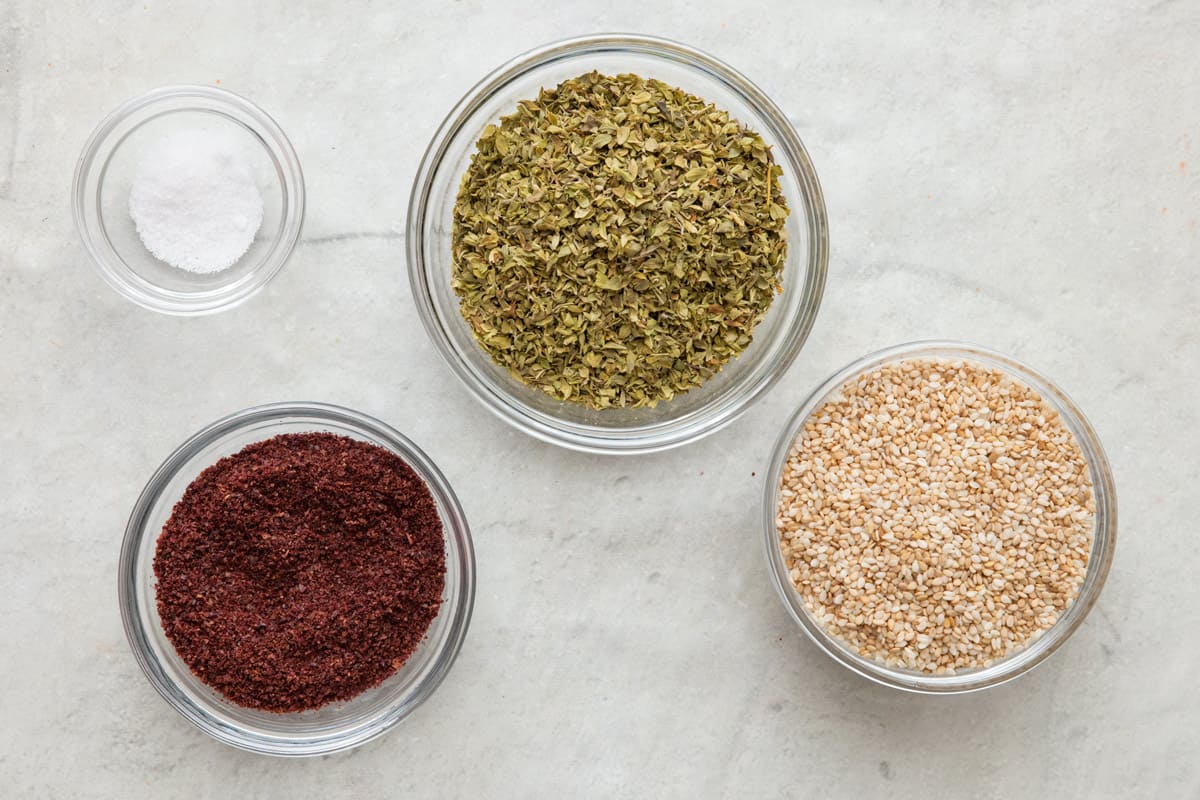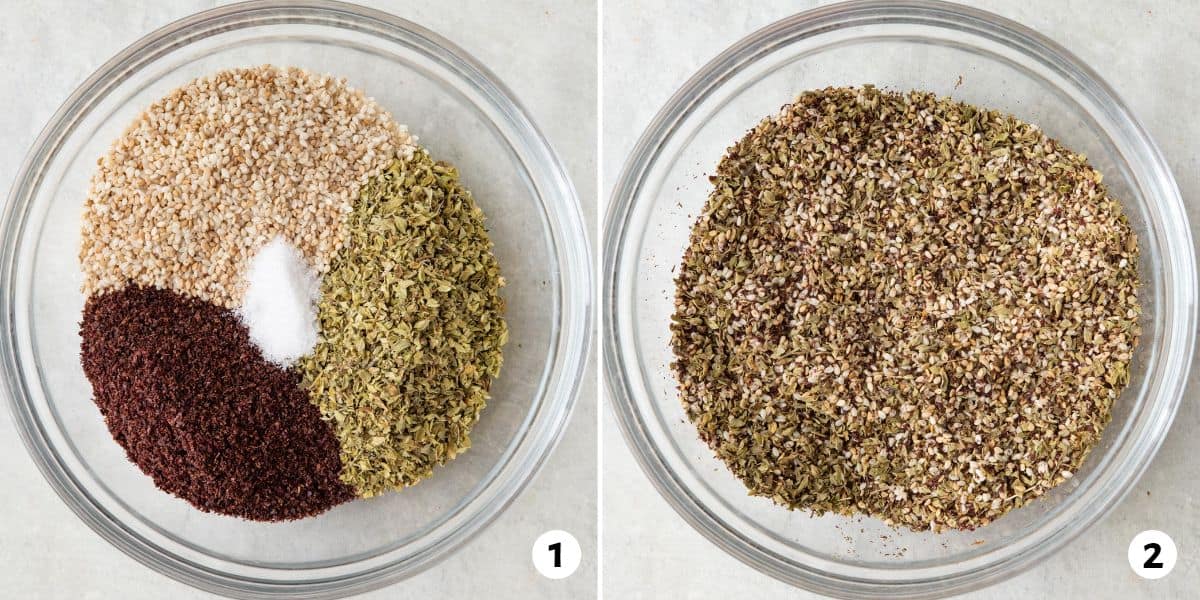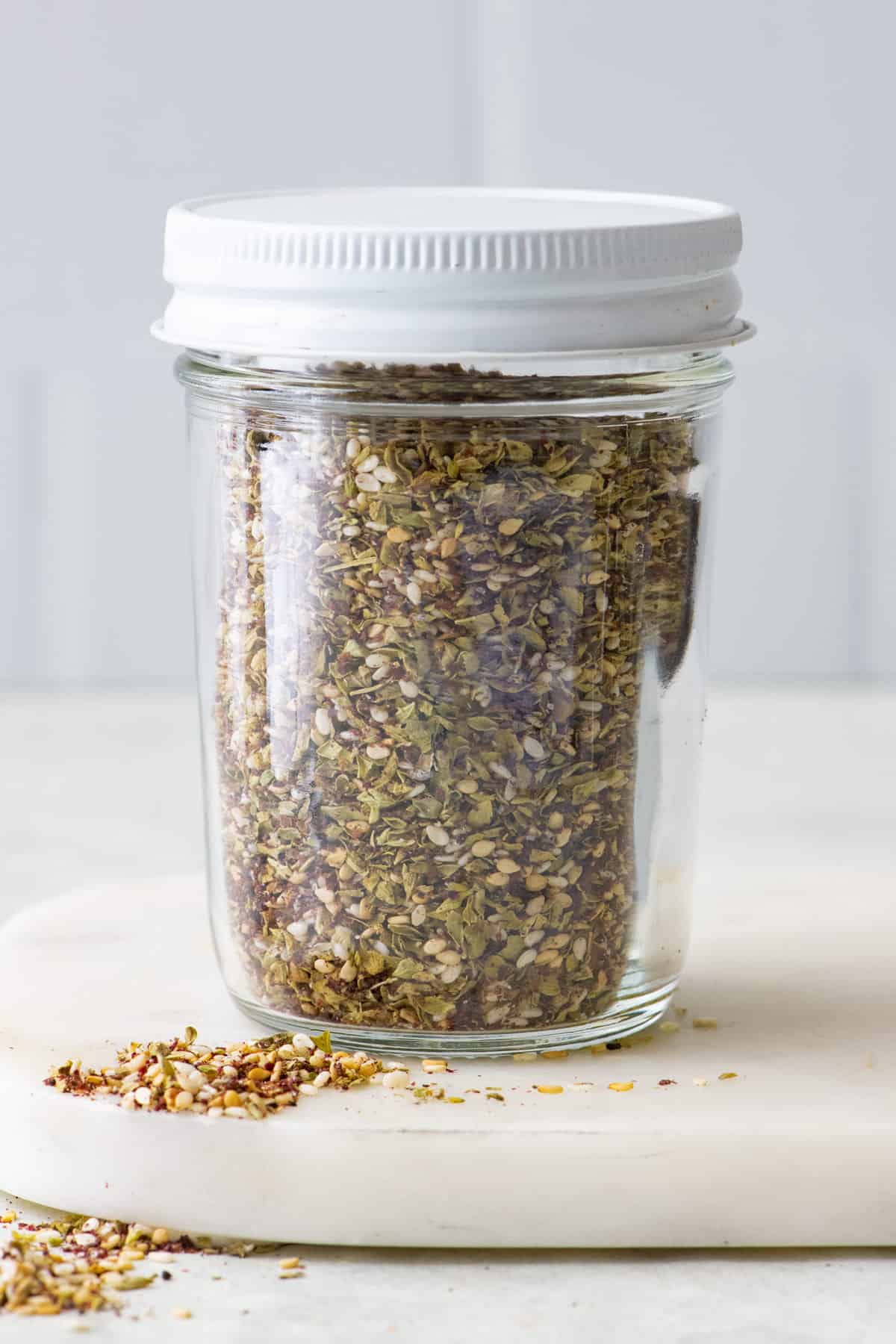How to Make Za’atar
Published Apr 28, 2023
Spice up your cooking with homemade za'atar! Learn how to make this tasty Middle Eastern seasoning with a few ingredients and simple steps.
This post may contain affiliate links. Please read our disclosure policy.
If you’re a fan of Middle Eastern cuisine, you’ve likely heard of za’atar, but did you know that learning how to make za’atar at home is incredibly easy? Za’atar seasoning is a flavorful spice blend that is so delicious to use in various dishes, from dips and spreads to meats and vegetables. In this guide, I’ll show you how to make a classic Lebanese za’atar spice blend from scratch and use it to add a unique flavor to your meals.

Jump to Section
Making za’atar seasoning is a simple and rewarding process that allows you to customize the blend to your liking. This traditional Lebanese za’atar recipe calls for a mixture of just 4 simple ingredients: dried thyme, sesame seeds, sumac, and salt. Still, you can experiment with different herbs and spices to create a unique flavor profile. Homemade za’atar also allows you to control the quality and freshness of the ingredients for a more potent and aromatic blend.
WHY you should learn how to make za’atar
- Easy to make. Most seasoning blends are effortless, and this is definitely one of them! No special steps, just combing aromatic and flavorful spices together.
- Unique and perfect for Middle Eastern cuisine! This is a common blend used in Lebanese and Middle Eastern recipes. The sumac is the most unique addition, with a dark red color with a similar flavor of freshly squeezed lemon juice that is a bit sweet and floral. It’s similar to coriander but much more vibrant.
- Control the quality. The best part about making your spice blends is that you have better control over what is being added and the quality of ingredients used!
Za’atar spice ingredients
- Dried oregano: You want to look for the oregano leaf and opt for a Mediterranean one, or if possible, one made in Lebanon like this one.
- Sumac: Similar to the dried oregano, I suggest using a Lebanese-made sumac like this one. You’ll get a more authentic flavor, and match premade za’atar more closely.
- Toasted sesame seeds: The more toasted, the better! You can toast your own sesame seeds or buy them pre-toasted. They add a wonderful nutty flavor and crunch to the seasoning blend.
- Salt: Use fine sea salt. It is a smaller granule than table salt that blends well with the other ingredients and melts away into your recipe when cooked.

HOW TO MAKE zaatar spice
- Add the ingredients to a small bowl.
- Mix well and transfer to a spice jar or airtight container.

TIPS on how to make the best za’atar seasoning
- Use fresh spices. Avoid reaching for that spice at the back of your cupboard that you’ve been holding on to for ages. Fresh spices will deliver the best flavor and higher potency, so it’s worth starting with a clean slate.
- Make a smaller batch. If you just want to try out the spice blend but are unsure if you want to commit to this size batch that makes about 1 ½ cups of za’atar (12 ounces), you can half or reduce the recipe. This would be ¼ cup oregano, ⅓ cup toasted sesame seeds, ⅛ cup sumac, and ¼ teaspoon of fine sea salt.
- Use toasted sesame seeds. You will get a much more impressive nutty flavor. You can buy them already toasted or use my quick guide for either toasting sesame seeds on the stove or in the oven.
- Experiment with ratios. Play around with the amount of each ingredient to create a blend that suits your taste buds.
Recipes & za’atar spice uses
Adding this fragrant spice blend to your Lebanese recipes is tip number 1! But you can also add it to a bit of olive oil for dipping bread, sprinkling over roasted veggies, in salad dressings and soup, as a dry rub for grilled meats, or as an extra flavor boost to dips like hummus or baba ghanoush. There are many ways to use za’atar, and here are some of my favorite recipes that feature this delicious spice blend.
- Zaatar Manakeesh
- Zaatar Spring Rolls
- Grilled Halloumi Cheese
- Homemade Labneh
- Lentil Salad
- Baked Za’atar Chicken
- Pomegranate Roasted Chicken Thighs
HOW TO store this Lebanese zaatar recipe
Store your in your pantry in an airtight container, such as a spice jar.
HOW LONG can I store za’atar?
Homemade za’atar can be stored in an airtight container in a cool, dry place, such as a pantry or cupboard, for up to 6 months. However, it’s important to note that the shelf life of your homemade za’atar may vary depending on the freshness and quality of the ingredients you used to make it.
CAN I FREEZE spices?
Yes! To extend the shelf life, you can store the za’atar seasoning in an airtight container or freezer bag and place it in the freezer. Try to push out as much air as possible for better storage.
Some herbs and spices in za’atar may lose their potency and aroma when frozen, so it’s best to use them within 6 months for optimal flavor.
FREQUENTLY ASKED QUESTIONS
Za’atar has a complex flavor profile that is herbaceous, slightly floral, tangy, and earthy, with notes of mint, nutty sesame, and lemony sumac.
Although the original spice blend is essential to achieving the signature Middle Eastern flavor, you can still make some substitutions if necessary.
Instead of dried thyme, substitute either dried oregano or marjoram.
You can use poppy seeds if you don’t have sesame seeds. Keep in mind that poppy seeds have a milder flavor, so you may want to use a bit more than the recipe calls for.
Dried lemon zest can substitute for sumac as they both have similar flavors.
Za’atar may taste bitter due to over-toasting of sesame seeds, using stale ingredients, incorrect ratios of herbs and spices, or burning the herbs while cooking.

This quick guide will show you how to make your za’atar spice blend with just a few ingredients and simple preparation. With its unique blend of herbs, sesame seeds, and sumac, za’atar is a versatile and flavorful seasoning that can be used in a variety of Middle Eastern recipes. Plus, with tips on how to store your DIY spices for freshness, you can enjoy them for months to come.
MORE seasoning tutorials:
- How to Make 7 Spice
- How to Make Taco Seasoning
- How to Make Lemon Pepper Seasoning
- How to Make Cajun Seasoning
If you found this tutorial for How to Make Za’atar helpful or if you try any recipe on Feel Good Foodie, then don’t forget to rate the recipe and leave a comment below! It helps others who are thinking of trying out this tutorial and we would love to hear about your experience. And if you snapped some shots, share it on Instagram so we can repost on Stories!

How to Make Za’atar
Ingredients
- ½ cup dried wild oregano leaves
- ⅔ cup toasted sesame seeds
- ¼ cup sumac
- ½ teaspoon fine sea salt
Instructions
- In a small bowl mix all ingredients together until well combined. Store in an airtight container for up to one month.
Notes
Nutrition
Nutrition information provided is an estimate. It will vary based on cooking method and specific ingredients used.





